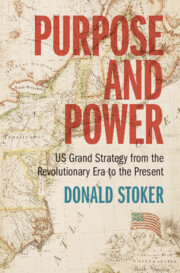Book contents
- Purpose and Power
- Purpose and Power
- Copyright page
- Dedication
- Contents
- Figures
- Maps
- Abbreviations
- Thinking about Grand Strategy in Peace and War
- Part I From Backwater to Great Power
- Part II From Great Power to Superpower
- 7 Stepping upon the Global Stage, 1913–1921
- 8 The Interwar Interlude, 1921–1939
- 9 Moving Astride the World: The Second World War, 1939–1945
- 10 The Hot Peace and the Korean War, 1945–1953
- 11 The Hot Peace: The Eisenhower, Kennedy, And Johnson Years, 1953–1969
- 12 The Vietnam War, 1961–1969
- 13 Détente and Defeat: Nixon, Ford, and Vietnam, 1969–1977
- 14 For Want of a Vision: The Carter Years, 1977–1981
- 15 Winning the Hot Peace: Reagan’s Great-Power Competition, 1981–1990
- Part III The Post–Cold War World
- Part IV Retreat and Defeat
- Acknowledgements
- Notes
- Index
9 - Moving Astride the World: The Second World War, 1939–1945
from Part II - From Great Power to Superpower
Published online by Cambridge University Press: 11 January 2024
- Purpose and Power
- Purpose and Power
- Copyright page
- Dedication
- Contents
- Figures
- Maps
- Abbreviations
- Thinking about Grand Strategy in Peace and War
- Part I From Backwater to Great Power
- Part II From Great Power to Superpower
- 7 Stepping upon the Global Stage, 1913–1921
- 8 The Interwar Interlude, 1921–1939
- 9 Moving Astride the World: The Second World War, 1939–1945
- 10 The Hot Peace and the Korean War, 1945–1953
- 11 The Hot Peace: The Eisenhower, Kennedy, And Johnson Years, 1953–1969
- 12 The Vietnam War, 1961–1969
- 13 Détente and Defeat: Nixon, Ford, and Vietnam, 1969–1977
- 14 For Want of a Vision: The Carter Years, 1977–1981
- 15 Winning the Hot Peace: Reagan’s Great-Power Competition, 1981–1990
- Part III The Post–Cold War World
- Part IV Retreat and Defeat
- Acknowledgements
- Notes
- Index
Summary
The Second World War made the US a superpower. As the international situation deteriorated, Roosevelt began supporting the Allies via Lend-Lease and rearming the US, particularly via navy bills, and made the US the “arsenal of democracy.” Hitler’s Nazi Germany, Mussolini’s Italy, and Tojo’s Japan formed the Tripartite Axis alliance. Roosevelt and Britain’s Winston Churchill agreed they would seek the defeat of the Axis, pursuing a “Germany First” offensive strategy while fighting defensively in the Pacific. The Allies argued over when and where to launch a Second Front and struggled to prepare the troops and material needed for this. The US and Great Britain defeated Germany’s U-boat campaign and launched a combined bomber offensive against Germany. The US and Britain fought in North Africa, then forced Italy from the war, and invaded Normandy, France, in Operation OVERLORD in June 1944. Germany surrendered in May 1945. In June 1942, the US won the pivotal Battle of Midway against Japan. The US then went on the offensive at Guadalcanal in the Solomon Islands. The US launched history’s most successful submarine guerre de course against Japan, while mounting a two-pronged Pacific offensive and seeking to destroy the Japanese Navy. The offensives met at the Philippines, and then leapt to Iwo Jima and Okinawa. The dropping of the atomic bombs pushed Japan to surrender. The “Big Three” settled the postwar situation at Yalta and Potsdam.
Keywords
- Type
- Chapter
- Information
- Purpose and PowerUS Grand Strategy from the Revolutionary Era to the Present, pp. 294 - 343Publisher: Cambridge University PressPrint publication year: 2024



